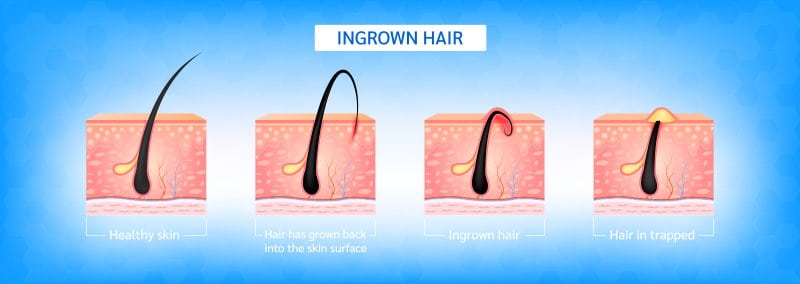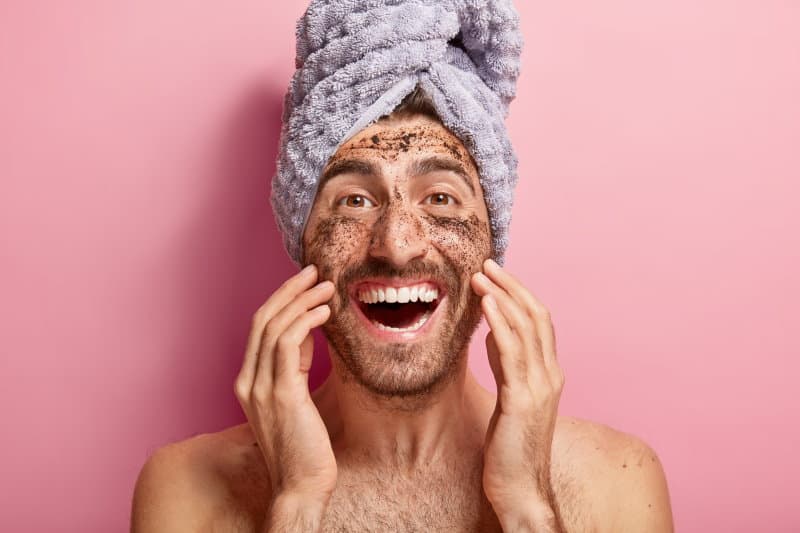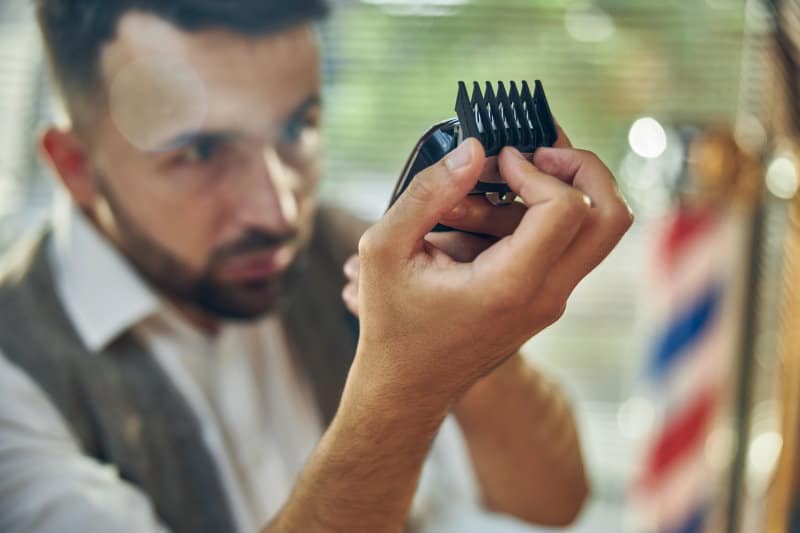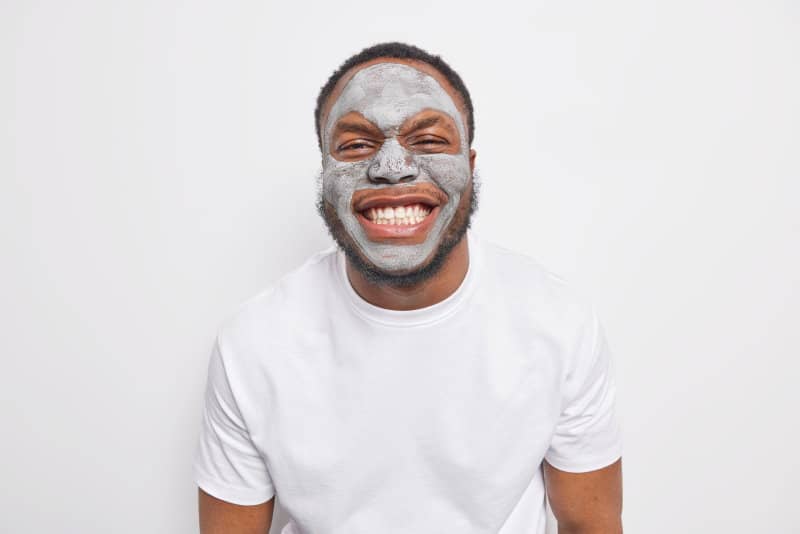Growing a beard is often considered an easy way out of the whole ingrown hairs debacle. It can be a quick solution to red pumps or scarring hyperpigmentation by hiding them under dense hair.
However, when the ingrown hairs on your bread get too visible and painful, that’s when things get really annoying.
So, is it possible to grow out a smooth full beard without itchy ingrown hairs?
Figuring out how to grow a beard without ingrown hairs comes down to a proper skincare routine. You have to balance exfoliation to remove dead skin cells and moisturizing to facilitate the hair’s way out.
Once you nail down a few basic steps, maintaining your beard to its full potential should be a breeze.
In this post, we go over some tips and tricks that can help you treat and prevent ingrown hairs while boosting beard growth.
Let’s dig in!
What’s Ingrown Hair All About?

Ingrown hairs happen when a previously removed hair fails to pop out of the pores on the skin surface normally.
This stuck hair recoils on itself under the skin, causing an inflammation that often turns into a painful and unsightly bacterial cyst with pus inside.
But that’s not all.
Too many ingrown hairs also mean that your beard is going to look less dense with a bunch of random sparse spots.
Unlike popular belief, shaving isn’t the only cause of ingrown hairs. Other factors go into play, from cell turnover rates to hydration levels.
Now that we’ve covered some basics, you might be wondering how you can prevent those irritating recoiling hairs?
How to Grow a Beard Without Ingrown Hairs With 11 Handy Tips
With a simple routine that balances the right amounts of exfoliation, hydration, and nutrition, you can stimulate beard growth and keep the ingrown hairs away.
Let’s take a look at 11 tips and tricks that will get you closer to the full beard you seek:
1. Use a Facial Cleanser
The right cleanser can unclog your pores, clear extra grease, and remove flakes. All this works to reduce ingrown hairs.
It’s not just that, though.
A lot gets deposited on your face throughout the day, and a fuzzy beard makes a great storage maze for all that dirt, sweat, and bacteria.
The accumulated pollution can also lead to early signs of wrinkling due to all that free radicals and smoke residue.
So, maybe think twice the next time you feel tempted to jump in bed without washing your face!
Finding the perfect cleansing product for your face can be a bit tricky at first. If you tend to have dry skin, try looking for alcohol-free products. Oil-free ones work well for people with greasy t-zones.
Once the beard gets long enough, reaching the skin with the cleanser is going to be a challenge.
In that case, you can use a scalp massager to gently lather the cleansing formula into your skin in a circular motion.
2. Warm Up Your Skin With a Hot Compress
Heat can open up the pores and prep the face to make the most out of the next skincare routine steps.
In fact, it’s even recommended to wet your beard with warm water before a clean shave to ease the gliding blade.
While the washing step itself needs lukewarm water, you can go for a warm compress over the beard area afterward.
You don’t have to cover your entire face in it, though. Just take a small cloth, dab it in warm water, and cover only the ingrown hair with it.
Some people like rubbing it all over, but that can be too much of an irritant fresh after a facial cleanse.
Just hold the compress in place for a couple of minutes and repeat 2-3 times till you see a satisfying result.
Give it a shot, but don’t go for a way too high water temperature. It should feel warm on your face, not scorching hot!
3. Exfoliate Your Skin Regularly With a Scrub

Just because the skin is under the beard doesn’t mean that it doesn’t need exfoliation. A suitable scrub has small particles that can mechanically clear up the dead skin over ingrown hairs.
If you’re lucky, you can also see improvement in dandruff after a couple of exfoliation sessions. Double win!
Timing is a major factor here. So, make sure your pores are all cleaned up. Ideally, I’d do it after dousing your beard with warm water or using a warm towel press.
Use a tiny bit on your fingertips and apply it as close to the skin as possible. In circular motions, spread the formula all over your face, paying particular attention to the spots with the most ingrown hairs.
The name of the game here is gentle scrubbing. Going back and forth might seem like it would provide the best results, but it can actually irritate the skin even more.
Don’t overdo it, though. Exfoliating once or twice should be more than enough.
4. Add a Dry Brush to Your Routine
If using scrubs aren’t your cup of tea, dry brushing might work out for you. It’s more convenient and less of a hassle.
However, many dry brushes are sold for legs, and they tend to be a bit too stiff for your face.
If you manage to find one with softer bristles, it can replace the regular scrub sessions entirely.
Those are already rare. So, don’t shy away from shopping the women’s skincare products aisle if you have to. A kids’ toothbrush can be a last resort for some people.
While body dry brushing can be part of your daily routine, facial ones should only be done once weekly.
To avoid bruising or irritating your skin, brush from the top down in gentle strokes.
Make sure you wash the flakes of dead skin away. Whether you use a dry brush or an exfoliating scrub, you’ll have to follow up with drying and adequately moisturizing your face.
5. Keep Your Skin Moisturized
You don’t have to be a skincare guru to know the importance of moisturizing your face, and the skin under your beard is no exception!
On average, moisturizing your face twice daily can soften your skin and help the growing hair make its way out smoothly.
Plus, hydrated skin is less likely to flake around hair follicles. These flakes often mimic dandruff, leaving a not-so-pleasant residue.
It can also clump and clog your pores, attract grease, and leave you at a higher risk of getting ingrown hairs.
Just be careful of over-hydrating the beard itself. Hygral fatigue is a thing, and it can turn a healthy beard into a sad frizzy one very quickly.
To avoid this, massage the moisturizer into the skin and avoid the hair shafts as much as possible. For a precise application, use one small dab on the tips of your fingers.
Whenever possible, go for creams with a breathable formula with low glycerin content under 5%. It’s a good humectant, but too much can leave your skin feeling tacky and suffocated.
6. Trim With Caution

Using a trimmer can give you ingrown hairs only if the foil cutter itself gets in touch with your skin.
However, if you use an attachment guard, you should keep the foil from getting in direct contact with your skin and tugging your hair follicles.
For instance, you can use a ¾-inch guard to maintain a short beard. This will keep the skin irritation to a minimum and help you get that tamed look all at once.
For longer beards, it might be easier to just use the comb and scissor method to snip the stray hairs and keep the bushy spots down.
If manual cutting isn’t your vibe, you might need to put in a bit more work in finding the ideal trimmers for thick beards.
If you outline your beard with a razor, make sure you shave with the grain and use a sharp blade every time.
Keeping your beard tamed won’t only boost your confidence, but it can also make it easier to locate those sneaky ingrown hairs. Keep your eyes peeled for those sparse spots!
Just make sure you don’t get way too overboard and go for a full clean shave. After all, to get a thick beard, you have to actually let the hair grow out.
7. Use a Beard Oil
People with curly hair patterns tend to suffer more from ingrown hairs. That’s partially because the hair curls on itself and inverts back on the skin to cause irritation, especially if it’s on the coarse side.
That’s where hair oil comes in.
Besides giving your beard a natural glow, using a nurturing oil can soften the growing hairs and reduce some of that irritating re-coil back.
It’s not necessarily a cure for ingrown beard hairs, but it’s a good preventative measure to keep the growth smooth. It can also encourage hair growth.
Keep in mind that not all oils are created equal.
It’s all about that ingredient list, and unfortunately, natural isn’t always better.
I get that deciphering an ingredient list can be hard, but if you know a little about non-comedogenic products, you’ll be fine.
Unlike popular belief, coconut oil isn’t all that good for you. Oils like jojoba, hemp seed, argan, and squalene are great options to consider with a low comedogenic rating.
We go on in more detail about how oils like argan help beard growth.
If you don’t want to bother buying raw oils, find a reliable brand of pre-mixed beard oils and save yourself the hassle.
Whatever you do, don’t depend on silicone-based beard serums. Those will clog up your pores, increasing the chances of getting ingrown hair and acne.
8. Treat Your Beard to a Mask

An aspirin and honey mask has antibacterial and anti-inflammatory properties, so it can help prevent turning an ingrown hair into an infected mess.
As a plus, the salicylic acid in it also helps clear out dandruff and dead skin flakes that contribute to ingrown hairs.
To prepare it, dissolve 2-3 aspirins in a spoon of water, then gradually mix in the honey to create a homogeneous paste. Rub it on your cleansed face, but don’t scrub it in.
If this sounds too sticky for you, try out aloe vera or a tea tree oil treatment.
Both of these natural ingredients reduce redness and pain from inflamed ingrown hair. It can also soften the skin on top a bit to facilitate the protrusion of the hair from under the layers of dead skin.
Another home remedy that can help clear our ingrown hairs is black tea bags. Yes, you heard it right: black tea spot masks for your beard.
After heating the tea bag with hot water, cool it down in a freezer, and apply it to the clogged hair follicles.
The tannic acid in tea is also good for inflammation. The only catch is that it’s not very convenient to use if you have a long, bushy beard.
9. Get Someone to Help You Pluck Stubborn Ingrowns
Sometimes, going in with topical remedies and a thorough skincare routine just doesn’t cut it with stubborn ingrown hairs.
If that’s the case, you might need a helping hand to fish out the stuck hairs from the layers of dead skin.
That can be a very risky process, though, and there’s a right way to go at it at home.
Start with a facial cleanser and apply a hot compress to the targeted spot for at least a whole uninterrupted minute.
Meanwhile, you’ll have to sterilize your facial tweezers with rubbing alcohol and let them dry out for a few seconds. This step is very important to prevent a nasty infection later on.
With the tweezer head closed shut, tease the hair out of the reddened skin. It’s crucial not to puncture the skin itself with tweezers.
Once you can visibly see the hair out of the skin, pull it out gently till you get the entire thing from the follicle.
When you’re done, wash the spot once again with warm water, then apply topical antibacterial cream for a couple of days as a preventative measure.
These methods work fine for superficial ingrown hairs, especially if you have someone to help you get to those hard-to-reach spots on the neck.
You’ll be shocked to see how much comes out from under your chin!
Wife just plucked some of my ingrown and abnormal beard hairs and OH MY GOD WHAT ARE THOSE pic.twitter.com/Cn6lAs8SDL
— Bamfing Bob (@bamfingbob) January 11, 2019
However, ingrown hairs that are deep under the skin will need more prep work to thin out the layers of dead skin.
10. Fight the Beard Starter Itch

Dense beards often get a bit too itchy, and you’ll be tempted to just shave it all off just to relieve yourself from the unforgettable sensation.
If you really want to grow out a luscious beard, do yourself a favor and put up with the itch.
After all, the hair is most uncomfortable when it’s grown out of the follicles, and it’ll fade with proper care routines.
If you really can’t tolerate the itch after all the previous tips and tricks, try using a topical corticosteroid cream on the ingrown hair follicles.
Use it for a maximum of five days. Longer usage of corticosteroids can result in a number of skin issues, including thinning skin, stretch marks, and scaling.
If nothing else works, you might be overdue for a visit to the dermatologist. You could be on your way to a fungal infection, especially if you notice a lot of balding spots.
In that case, you’ll be prescribed an anti-fungal treatment that could be a combination of topical and oral medication. Once you’re done with the treatment plan, you can focus on beard growth.
11. Work on Your Nutritional Balance
You can work on the surface level all you want, but if you neglect the nutritional side of things, you’ll still struggle to grow out the perfect beard.
To boost your beard hair growth, make sure you’re eating a balanced diet with a lot of vitamins and trace elements.
Pay particular attention to foods rich in vitamins A, B, C, and E.
For a start, vitamin A aids all cellular growth. That includes both skin and hair cells. Vitamin B (biotin) is also associated with speedy hair growth.
Meanwhile, vitamin C helps fight off free radicals and hinder growth and clog pores. As an antioxidant, vitamin E also keeps the free radicals from attacking the hair follicles.
Adequate zinc intake is great for your skin, hair, and nails. In fact, excessive hair loss is sometimes a symptom of zinc deficiency.
You’ll still need to monitor your iron level, too. It’s a crucial co-enzyme in many biological reactions needed for cellular growth.
A balanced diet with a lot of diversity can be enough to provide your body with all the building blocks it needs to keep your skin and hair healthy.
However, if you need an extra boost, you can resort to nutritional supplements to balance out any deficiencies you might have.
Conclusion
Figuring out how to grow a beard without ingrown hairs can be a battle uphill, but it’s not impossible.
So, be patient and stick to a skincare routine that works for you. Soon, you’ll be showing off that full beard!
By then, you might face an entirely new challenge since getting used to a thick beard can be a bit hard at first. Even the most mundane activities can feel weird.
Ever wondered if sleeping on your side has any effect on your beard? Let’s find out here!

